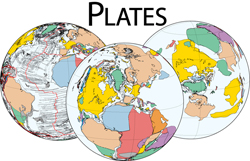A program of research into plate tectonics and geologic reconstructions, the PLATES Project was supported by an industry consortium. Our primary objectives included:
To model past and present plate movement. Construct accurate, high resolution global, regional or local plate models.
To compile comprehensive databases. Apply geographical, geological and geophysical data to plate models.
To develop plate motion computer software. Manipulate and display plate models, reconstructions, and databases.
To apply plate motion models. Use models to examine geological problems of global and regional extent.
Plate tectonics is a powerful tool for reconstructing (i.e. "predicting") geological environments through geologic history, particularly if the underlying plate motion model is accurate and detailed. PLATES tools are especially useful to groups engaged in exploration for hydrocarbons or minerals on global and regional scales. PLATES reconstructions provide a solid framework on which to build detailed geological models, such as basin response to regional crustal motion, likely sequences of depositional paleoenvironment, or probable geothermal consequences of plate position or movement.
The Work
PLATES maintains an up-to-date oceanic magnetic and tectonic database, continuously adding new paleomagnetic, hot spot, geological and geophysical data to extend the span and accuracy of global plate reconstructions. PLATES' reconstructions are built around a comprehensive database of finite-difference poles of rotation, derived both from extensive plate motion research at UTIG, using the PLATES interactive plate modeling software, and from published studies. Updated plate motion models are in turn applied to regional tectonic studies by PLATES investigators and collaborators and by project sponsors. The plate model developed by the PLATES Project describes the evolution of the earth's oceans and the movement of the earth's tectonic plates from the Late Precambrian through the present day.
The Team
PLATES scientists are Dr. Lawrence Lawver, Dr. Ian Dalziel and Dr. Ian Norton. Dr. Lawver's research areas include the tectonics of the Arctic/Antarctic polar regions. Dr. Lawver supervises the work done by PLATES students on the tectonic evolution of East and Southeast Asia. Dr. Dalziel focusses on PreCambrian tectonics as well as the tectonics of Antarctica. Dr. Norton focuses on understanding the structural evolution of continental margins, particularly trying to reconcile deformation amounts that can be predicted from regional-scale plate reconstructions with deformation that can be inferred from local-scale structural data. Marcy Davis is the contact (plates@utig.ig.utexas.edu) for the PLATES Project.
Collaborative Efforts
PLATES researchers and students have a long history of collaboration with researchers outside of UTIG. Results from the PLATES Project are described in various publications.
- Tectonics Special Research Centre, University of Western Australia
- The South Atlantic Project (a collaborative effort with CASP; Centro de Investigaciones Geologicas, La Plata, Argentina; Department of Geology and Petroleum Geology, University of Aberdeen; and Department of Geology and Geophysics, University of Edinburgh)
- To obtain an “AGE OF THE OCEAN FLOOR POSTER”, see the NOAA announcement
- A Global Isochron Chart (University of Texas Institute for Geophysics Technical Report No. 117, 1992; PDF file).





